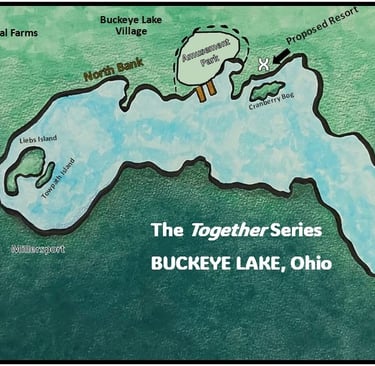Fact and Fiction in Pressed Together
Note: There could be spoilers here. I recommend reading this only when you’ve finished reading the novel!
5/7/20244 min read


While there may be accidental errors in my first novel Pressed Together, I wanted to be clear about which aspects of 1940s Buckeye Lake are intentionally true and intentionally “stretched.”
See, for a long time, I had the story taking place in a made-up setting called Cardinal Lake (figuring if I wasn’t going to acknowledge the state tree, I could at least pay tribute to the state bird). Why did I resist setting Drew’s and Emily’s story in the real Buckeye Lake that inspired it? It’s because I didn’t want to compromise aspects of the story I valued in exchange for strict historical accuracy. Sometimes, as a writer, I just want to play while telling a tale.
In the final months before the book went into contract, however, I began to feel bad for not doing what I could to celebrate the real place and real community that had influenced me in so many ways and had impacted others’ entire lives. I took a deep breath, did some research, and converted my made-up Cardinal Lake back into the real Buckeye Lake … from my grandparents’ time.
In the end, as indicated, I left some aspects of the narrative as they were for the sake of the pace or setting. Other parts are a quiet tribute to the truth as I understood it in my own time as a reporter at the lake.
Let’s start with those TRUE parts
The amusement park really did have paid gimmicks or “free acts” every season, and I captured some of those in the novel: a horse that dove from a platform into water; a man in an underwater submarine; live seals; a hirewire cyclist. There were more creative acts that I didn’t have room to do justice to!
The guy supposed to spend the summer on the high wire at Buckeye Lake’s park really did come down early when he spotted his girl stepping out with another fella. Listen to the late Donna Braig tell that story on the museum’s website! You’ll love it.
The drugstore on the midway did sell carved coconut heads as souvenirs, which cracks me up. It had to go in the book. When I think about it, though, I suppose Buckeye Lake might have been as close to a tropical ocean as some people in the Midwest got.
“Dummy days.” One of the trickiest research pieces in this book was getting the publishing process right. In my time at The Beacon, we were doing paste-up and imaging, and the Mount Vernon News printed our paper each week (it was 36 pages some weeks when I first started). Emily was publishing in a transitional time, though, when a small paper would likely have used a Mergenthaler linotype machine. It would be time consuming. I consulted two different press historians (mentioned in the book’s Acknowledgements) about what options I had to get Emily out of the office, and we landed on the printing arrangement you see in the novel.
Everything about the vomiting blue heron is biologically accurate.
Liebs Island is real. TowPath Island is real, though a lot of people at the lake don’t know it’s referred to as that … it’s by Fisher’s Marina. Fisher’s Marina, by the way, was around during the time of my novel, and it did have a beach. The barge house on the towpath was real. I wrote about and saw it a few times.
Chris-Craft boats really were all the rage on Buckeye Lake. I first encountered them when I was covering an Antique Wooden Boat Show at the Buckeye Lake Yacht Club. They are gorgeous.
There were, in fact, several fires at the amusement park. Most everything was wooden. The museum is doing a podcast on this. Find their podcast at Body Talk - Buckeye Lake on YouTube.
I really got to watch one of the Dodge ‘Em cars pulled out of the mud under the lake water on the north shore. A crane pulled it out from where it had slid down there during a fire, I was told. Watching history unearthed that day was one of the things that most captured my imagination about that old park. I think you’ll recognize that from the end of the book.
Stuff I Made Up (or altered)
The Buckeye Lake Beacon was, indeed, a weekly newspaper that served the lake area for a time … beginning in the 1990s, not the 1940s. For historical accuracy, I have to give a shout out to the Buckeye Lake Shopper-Reporter, which has been publishing for more than sixty years and is a true staple of the lake. Still, The Beacon is where I got my first paid writing gig in 1998 as a full-time reporter. As a tribute to owner Charlie Prince, I wanted Emily to be a bit hard-hitting in her small town news coverage. She’s a journalist, as is Charlie, who sacrificed week after week to try to be a voice of change.
As mentioned in the book’s Author’s Note, Buckeye Lake wouldn’t become a village, technically, until about fifty years ago. To that end, there was no Buckeye Lake Police Department in 1946. The county sheriff’s office had jurisdiction at the amusement park in those days.
Speaking of the amusement park, my geography is a bit loosey-goosey in the novel. I’ve got The Dips coaster running near Drew and Emily on the boardwalk, but it really would have been north of there, stretching out over the Little Lake rather than the main lake. Also, the Crystal Ballroom is not where I situated it, either, though the venue was a real place.
Nothing about Dottie Berkeley’s family owning the whole park is true at all.
I made up Festival Farms. There are several big farming families around the lake, but Smokey’s situation is fiction. He himself is, however, a tribute to an uncle my mom loved who was a frog man in the war (precursor to the Navy Seals). More on him in Book 3.
Smaller things I made up: road names and restaurant names in the novel.
Unfortunately, Rosie Graham’s Sweetheart’s Canal by the towpath is a product of my romantic imagination. Could someone please put some spotlights and glasswork along there?
If you spot things in Pressed Together I’ve forgotten here, please reach out, and I’ll add an “Apology” section to this post. Also, please let me know if you have questions I can research and answer related to any of this! I’m eager to learn and share, and the volunteers at the museum are so patient and generous with me. My mom finished the novel and said, “I want to go see where some of these places were.” If you’d like to ride along with us, the only charge will be a pizza we can share at the Pizza Cottage!


